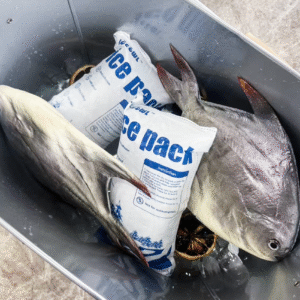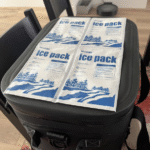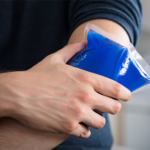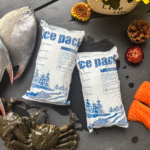Überlandversand mit Trockeneis-Eisbeuteln: A 2025 Guide to Safe and Efficient Shipping
Shipping perishable goods across the country presents numerous challenges, but with the right knowledge and preparation, you can ensure your goods stay safe and fresh. Dry ice ice packs are a reliable solution for maintaining the necessary temperatures during transit. This guide will explain the best practices, safety regulations, and shipping innovations for using dry ice ice packs in cross-country shipments.
What Are Dry Ice Ice Packs and How Do They Work?
Trockeneis ist die feste Form von Kohlendioxid (Co₂), die bei -78,5 ° C direkt in Gas untermüßt (-109.3° F). When used in ice packs, it provides powerful cooling for perishable goods without leaving any liquid residue. Dry ice ice packs are often used to maintain frozen temperatures for extended periods during shipping.
How Do Dry Ice Ice Packs Work?
Dry ice ice packs are typically used in insulated shipping containers, where they maintain a cold environment for days, making them ideal for shipping sensitive products like biological samples, Impfungen, Essen, und Pharmazeutika. They are more effective for longer distances than gel or water-based ice packs, as dry ice can stay cold much longer.
Schlüsselspitze: Ensure proper ventilation when using dry ice in shipping containers. Als Trockeneis untermauert, it turns into carbon dioxide gas, which can cause pressure buildup in an enclosed space. Proper venting is necessary to prevent container rupture.
Safety and Handling of Dry Ice Ice Packs
How Can You Safely Handle Dry Ice Ice Packs?
Handling dry ice safely is essential due to its extremely low temperature, which can cause frostbite and skin damage if not properly managed. Here are a few safety guidelines:
-
Schutzausrüstung tragen: Always wear insulated gloves and eye protection when handling dry ice to prevent frostbite.
-
Ordnungsgemäße Belüftung: Ensure shipping containers have ventilation to allow the release of carbon dioxide gas.
-
Use Appropriate Packaging: Choose well-insulated containers designed for dry ice to prevent heat exchange.
Common Safety Practices
| Sicherheitsmaßnahmen | Empfehlung | Warum ist es wichtig |
|---|---|---|
| Ventilated Packaging | Ensure boxes have ventilation holes. | Prevents CO2 gas buildup, which can be hazardous. |
| Proper Gloves | Use insulated gloves when handling dry ice. | Protects from frostbite and skin burns caused by contact with dry ice. |
| Clear Labeling | Label packages with “Trockeneis” and UN number. | Ensures handlers understand the danger, leading to proper handling. |
Legal Requirements and Regulations for Shipping Dry Ice
What Are the Legal Guidelines for Shipping Dry Ice?
Shipping dry ice involves complying with both safety and environmental regulations. These rules ensure that dry ice is transported correctly without posing a risk to handlers or the environment.
-
Beschriftung: Packages containing dry ice must be labeled with the “Trockeneis” symbol, die UN -Nummer, und das Nettogewicht des Trockeneis.
-
Quantity Limits: The maximum amount of dry ice allowed for air shipments is 5.5 kg (12 lbs) per container. For cargo shipments, bis zu 200 kg (440 lbs) may be permitted.
-
IATA Regulations: Dry ice used in air travel must adhere to IATA (Internationale Luftverkehrsvereinigung) Vorschriften, which require specific packaging to allow the safe release of CO2 gas.
Erinnerung: Always verify the latest regulations before shipping to avoid fines and ensure compliance.
Best Practices for Shipping Dry Ice Ice Packs Cross-Country
How Can You Ensure Safe Shipping with Dry Ice Ice Packs?
-
Wählen Sie die richtige Verpackung: Insulated boxes designed for dry ice shipments are essential. These containers minimize temperature fluctuations and prevent the dry ice from sublimating too quickly.
-
Berechnen Sie die richtige Menge Trockeneis: The amount of dry ice you use depends on the size of the shipment and how long it will take to reach the destination. Using a dry ice calculator can help you determine the precise amount for your needs.
-
Überwachen Sie die Temperatur: Including a temperature monitor in the shipping container is crucial, especially when shipping temperature-sensitive items like medical samples and vaccines.
How to Choose the Best Dry Ice Ice Pack for Your Shipment
When selecting dry ice ice packs, consider the following factors to ensure your goods remain at the proper temperature:
| Faktor | Option A | Option B | Why You Should Care |
|---|---|---|---|
| Kühldauer | 24 Std. | 48 Std. | Longer cooling times may be necessary for cross-country shipments. |
| Size/Shape of Ice Pack | Sheet | Block | Sheets are easier to fit into irregular spaces, while blocks offer longer cooling durations. |
2025 Trends bei Trockeneisschifffahrt
Neueste Entwicklungen bei Trockeneisschifffahrts
Von 2025, the dry ice shipping industry has been shaped by innovations aimed at improving the efficiency and sustainability of cold chain logistics.
-
Automatisierung in der Logistik: Automated systems for handling dry ice reduce errors in packaging and transportation.
-
Temperaturkontrollierte Verpackung: Advancements in packaging technology now offer better insulation, making dry ice shipping more cost-effective and environmentally friendly.
-
AI in Logistics: AI-driven systems are now capable of tracking shipments in real-time, optimizing cooling mechanisms based on weather data to extend the shelf life of perishable goods.
Markteinsicht: Consumers are increasingly demanding faster deliveries, insbesondere für verderbliche Güter, and the cold chain shipping industry is responding with AI-powered logistics, improving delivery times while reducing costs.
Häufig gestellte Fragen (FAQ)
How Much Dry Ice Should I Use for a 2-Day Shipment?
Für eine 2-tägige Sendung, it’s recommended to use approximately 20 LBS Trockeneis, taking into account the insulation quality and temperature conditions.
Can I Ship Dry Ice Internationally?
Ja, Trockeneis kann international versendet werden, but you must adhere to the regulations in both the originating and destination countries.
What Are the Labeling Requirements for Dry Ice Shipments?
Packages must be clearly labeled with “Trockeneis” oder “Kohlendioxid, Solide,” die UN -Nummer, net weight of dry ice, and include a Class 9 hazard label for air shipments.
Schlussfolgerung und Empfehlungen
Key Takeaways
-
Dry ice ice packs are an excellent choice for maintaining cold chain integrity in cross-country shipments, particularly for sensitive and perishable goods.
-
Always follow proper safety protocols when handling dry ice and ensure compliance with legal regulations to avoid shipping delays and fines.
-
Monitor temperature closely during transit and use fast shipping methods to reduce the chances of spoilage.
Nächste Schritte
If you are planning to ship cross-country with dry ice, use the guidelines provided above to ensure your shipment is safe and efficient. Ensure you calculate the appropriate amount of dry ice for the duration of the shipment and choose the right packaging. Working with a reliable logistics partner can further streamline the process and help you stay compliant with the latest regulations.
Über Tempk:
Tempk is a leading provider of cold chain solutions, offering high-performance dry ice packs, Gelpackungen, Isoliertaschen, and smart coolers. We specialize in ensuring the safe, zuverlässig, and eco-friendly transport of perishable goods across the country. Unser r&D center tests every product to ensure it meets the latest industry standards, helping clients maintain product integrity throughout the entire shipping process.
For expert advice or more information, contact Tempk’s team of cold chain specialists today.























